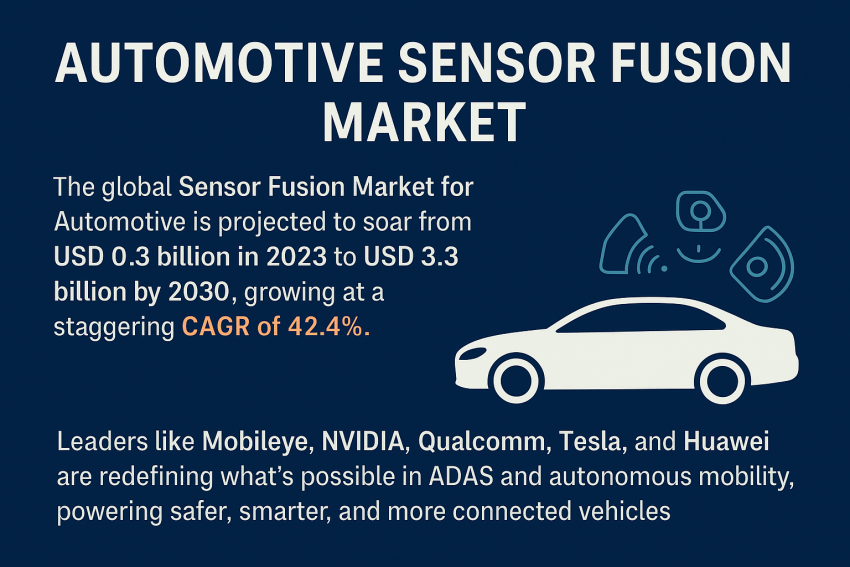The global Automotive Sensor Fusion Market Size is expected to expand tenfold by 2030. Factors such as increasing vehicle automation, safety regulations, and the shift toward connected mobility are driving demand.
Moreover, growing consumer interest in ADAS-equipped vehicles and the deployment of autonomous fleets in logistics and mobility services are set to further propel market growth.
Key Market Trends and Innovations
- Rising integration of AI and deep learning for real-time object detection and environmental modeling.
- Growth in multi-sensor systems for redundancy and accuracy.
- Collaboration between OEMs and technology providers to accelerate Level 3–Level 4 autonomy.
- Expansion of software-defined vehicle platforms supporting over-the-air updates and modular sensor architectures.
Data Fusion – The Largest Segment by Fusion Level
Data fusion is projected to dominate the market by 2030. It involves combining inputs from multiple sensors to produce a more accurate, reliable representation of the vehicle’s surroundings.
Companies such as LeddarTech (Canada), Robert Bosch GmbH (Germany), and BASELABS GmbH (Germany) are leading in data-level fusion solutions for autonomous vehicles.
By integrating complementary sensor data streams, these systems enhance situational awareness, minimize perception errors, and enable real-time decision-making — critical for autonomous navigation. While this approach increases accuracy, it also demands high computational power, slightly raising system costs.
Download PDF Brochure @ https://www.marketsandmarkets.com/pdfdownloadNew.asp?id=260287840
Autonomous Driving – Fastest Growing Application
The autonomous driving segment is set to record the highest growth rate during the forecast period.
Autonomous vehicles rely on sensor fusion to merge inputs from cameras, radar, LiDAR, and ultrasonic sensors, creating a unified environmental model. Combined with machine learning and artificial intelligence, these systems interpret data, predict object behavior, and make driving decisions with minimal human input.
Key players such as Mobileye, NVIDIA, Qualcomm, Robert Bosch GmbH, Waymo LLC, and Continental AG are developing SoCs and operating systems for Level 3–4 autonomous vehicles.
For instance:
- Mobileye’s EyeQ5 SoC provides supercomputer-level performance with low power consumption.
- NVIDIA’s Drive Orin and Drive Thor SoCs are already adopted by Mercedes-Benz and other OEMs for advanced autonomous driving platforms.
- BMW and Valeo’s partnership (June 2022) aim to develop Level 4 automated parking solutions.
Regional Insights: Europe – The Second Fastest-Growing Market
Europe remains a key hub for the automotive industry, with over 320 assembly and production plants as of 2022. The region’s emphasis on vehicle safety, emission reduction, and automation is driving strong adoption of sensor fusion technologies.
- Germany, France, and the UK have already approved autonomous vehicle operations on public roads.
- The EU safety regulation (July 2022) mandates ADAS features such as lane departure warning, automatic emergency braking, and drowsiness detection in all new vehicles.
- Germany’s Autonomous Driving Act (2021) made it the first country to allow Level 4 autonomous vehicles on public roads without human backup.
These initiatives, combined with OEM adoption of electric and autonomous platforms, make Europe a pivotal market for sensor fusion technology growth.
Competitive Landscape: Key Players
The automotive sensor fusion market is highly competitive, and technology driven. Leading players include:
- Mobileye Global Inc. (Israel)
- NVIDIA Corporation (US)
- Qualcomm Incorporated (US)
- Tesla Inc. (US)
- Huawei Technologies Co., Ltd. (China)
- Robert Bosch GmbH (Germany)
- Continental AG (Germany)
- LeddarTech (Canada)
- BASELABS GmbH (Germany)
These companies are focusing on partnerships, AI-driven R&D, and hardware-software integration to capture market share in the fast-evolving landscape of autonomous mobility.
🔮 Future Outlook
The future of the automotive sensor fusion market lies in seamless integration between hardware, AI, and software-defined architectures. As vehicles transition to fully autonomous systems, the reliance on high-accuracy, real-time sensor data fusion will become non-negotiable.
By 2030, advancements in semiconductors, 5G connectivity, and cloud-based data processing will further redefine the boundaries of autonomous driving.
Request Free Sample Report @ https://www.marketsandmarkets.com/requestsampleNew.asp?id=260287840

